What Is a Newsletter: A Beginner’s Guide with Examples & Tools
In our modern digital world, email newsletters are not just a means of sharing interesting content with peers anymore. Instead, they have become powerful tools for digital marketers and businesses to engage their audiences and promote their brands.
Join me today to uncover this compelling means of communication and learn how to do it yourself.
What Is a Newsletter? (And What It’s Not)
A newsletter is a type of email communication that gives subscribers news, announcements, or other types of content from brands on a regular, scheduled basis.
Subscribers use newsletters to get useful and interesting content, receive custom sales offers, or stay up to date on the latest news and important events of the brand.
Here’s what a typical newsletter looks like.

This example from TripAdvisor is a brand announcement sharing the results of one of their competitions.
We discussed what a newsletter is, but it is also important to understand what it is not. A newsletter is not:
- A short-term marketing campaign – a newsletter delivers long-term value to you and your customers
- A notification or reminder – a newsletter is not a one-time message
- Transactional content like verification emails and order summaries – newsletters share interesting content with your email subscribers.
Now that you have a basic understanding of what a newsletter is about, let’s discuss the reasons brands use newsletters.
What Is a Newsletter’s Purpose?
From the point of view of brands that spend time and resources creating and managing these campaigns, the purpose of a newsletter is to serve as an additional channel of communication they can use to promote their brand.
There are two key characteristics that make email newsletters a compelling option for brands:
Regularity: send out newsletters to your audience on a regular basis (e.g., weekly or monthly). By sharing relevant and valuable content consistently, your subscribers can consume it continually, inspiring them to stay engaged and interested in your brand.
Expectations of your subscribers: unlike brand pitch cold emails, where the recipient does not expect to receive a message from you, newsletter subscribers proactively express their interest in receiving your emails on a regular basis.
Email newsletters establish regular communication and user expectations, resulting in a series of benefits. Let’s list a couple of them next.
5 Main Benefits of Sending a Newsletter
I am pretty sure you have subscribed to at least a couple of newsletters in the last couple of years.
You probably had a clear understanding of the benefits expected from these newsletters, such as quality content or interesting news.
But have you ever wondered what benefits the companies were getting by sending you these newsletters?
Well, there are plenty; here are five of the most important ones.
Benefit #1: Relationship building
Newsletters can serve as a great medium of communication for building relationships between your brand and your target audience. You can contribute to this relationship-building process by sharing relevant and valuable content with your users and gaining their trust.
Here are two reasons why newsletters build relationships.
Content Relevance
Current individual and B2B email marketing tools you can use to send out your newsletters allow you to segment your audiences based on their needs and interests. This feature means the content each subscriber receives contains the information they find valuable and interesting.
As a result, they see you as a brand that knows what they want.
Constant Communication
The regular nature of email newsletters (your subscribers constantly see your brand name in their inbox) helps your users develop a sense of familiarity with your brand.
Benefit #2: Lead generation
Although you will most likely have dedicated email campaigns for generating leads and passing them through your funnels, you can consider using your email newsletter templates to help you attract potential customers as well.
In fact, email newsletters have a couple of great benefits when it comes to lead generation.
Engaged Subscribers
Your audience consists of people who have seen your subscription CTA while roaming your website, clicked on it, and joined your email newsletter.
The fact that they have proactively subscribed to get more content from you demonstrates that they are interested in your brand and products—making them a high-quality target for converting into a paying customer.
Middle of the Funnel (MoFu) Content Delivery
Since email newsletters deliver middle-of-the-funnel informational content, you can use them to warm up leads who want to learn more about your brand or industry news (can be both).
Apart from that, sending out MoFu content is a natural way to establish yourself as the authority in your industry and niche.
Organically-placed CTAs
Newsletters are also an excellent opportunity to talk about what you have to offer. Incorporate CTAs to take your users to landing pages where they can request a demo or sign up for your services.
In fact, a well-placed CTA in an email containing the proper wording can lead to a 16-fold increase in sales.
Benefit #3: Brand awareness
Another great benefit you can expect from your email newsletter campaign is an increase in brand awareness.
You can achieve this awareness by constantly sharing content with your users about your brand’s story and presenting your values and mission.
Some common ways to implement a brand storytelling campaign using your newsletters include:
- Sharing success stories and case studies demonstrating how you successfully met customer needs and employed your core values in practice.
- Sending “behind the scenes” content that shows how your team is working on covering the needs of your customers and delivering exceptional results to them. This strategy is a great demonstration of your brand values.
Apart from using newsletters as a platform for promoting your brand story, you can also take advantage of them to share the eye-catching visual elements of your brand with your subscriber list.
These elements include your brand colors, logo, and your visual style.
By constantly exposing your new subscribers to your visual branding, you increase the chances of them recognizing you among the crowd.
Benefit #4: Credibility and authority
As I mentioned earlier, email newsletters can also serve as a great platform for sharing content that demonstrates your expertise and thought leadership in your industry.
Here are some of the common types of such content.
Research Papers
Conduct research regarding a specific topic or area in your industry. Then gather data, analyze it, and share the results with your subscribers.
For instance, if you were an email marketing service, you could analyze all the emails sent through your platform and determine the best time and day of the week to send emails for each industry. Afterwards, you can share these findings with your newsletter subscribers.
Industry News and Commentary
An alternative way to demonstrate that you and your teammates are experts in your industry is by sharing the latest news relevant to your craft and adding your own commentary and analysis to it.
Participation in Trade Shows
If you are taking part in a trade show popular for your industry, talk about it in your newsletter.
A great hack for engaging your audience and building credibility is inviting your newsletter subscribers to the talks about industry-specific topics your teammates give during the trade shows.
Benefit #5: Audience insights
The final benefit of email newsletters I would like to talk about is the analytics data and insights about your audience (e.g., telling if someone read your email).
You can use this information to build your buyer’s persona that describes the needs, habits, and interests of your users and adjust your email marketing strategy to target them specifically.
To gather analytical data from your newsletter audience, you can use these tricks below.
Questions on Signup
When your website visitors click on a CTA prompting them to subscribe to your newsletter, you can take them to a small form. There, they can share information about their demographics, industry, or areas of interest before you add them to your list of subscribers.
Email Engagement KPIs
The majority of email marketing tools you can use to run your email newsletter campaigns come with analytics suites that can measure some of your main engagement metrics. For instance, it can be open rate, bounce rate, click-through rate, and conversion rate.
Link and CTA Clicks
You are usually very limited in tracking how your users interact with the content of your email. Overall, email clients don’t really like tracking code running inside an email.
However, you can still track the number of clicks on the links and CTAs you have in your email by using UTM tags.
To sum up, email newsletters are a great channel for communicating with your audience, building relationships with them based on trust and authority, and encouraging them to convert to paying customers.
Now, to help you take advantage of these benefits, let me share a couple of practical use cases of email newsletters.
4 Newsletter Use Cases to Keep in Mind
All types of email marketing, including newsletter marketing, are disciplines with a lot of creative freedom. You can use your newsletters to talk about practically anything you want; there are no strict rules on what a newsletter should look like.
There are, however, lots of well-tested use cases that can help you achieve your marketing goals. Let’s look at a couple of them, along with some effective newsletter examples.
Use Case #1: Content promotion
The most common CTA for email newsletters is usually something like this:
“Subscribe to our newsletter, and we will deliver some of the best stories and guides on {your_industry} right into your inbox!”
This case is typical when the benefit your users get by subscribing to your newsletter is the content related to their industry.
This use case creates a win-win situation, as it is not only your subscribers that benefit from the content but you as a business too. What you get is better visibility and traction for the pieces of content you have created and the possibility of converting your readers into leads in case you share ToFu or MoFu content.
The email with a content promotion that I will share next is a typical representation of MoFu lead generation content marketing strategy.
Example: Sequoia Capital

Here we have the famous venture capital firm Sequoia, one of the main sources of investor funds for startups. Their portfolio includes known software giants like Zoom, Instagram, and WhatsApp.
If you subscribe to Sequoia’s newsletter, you will receive emails with great copywriting about case studies and success stories like the story of Ryan Dahl—a Sequoia-invested founder.
These stories aim to create a connection in your mind between getting Sequoia’s investment and succeeding at your startup. The firm hopes to encourage more startup founders to request their investment by employing this strategy.
Use Case #2: Company announcements
Is there something compelling and important that your company would like to tell its audience?
Newsletters are here to help you with that! They are a good fit for sharing news, as your subscribers have signed up for them with the expectation of receiving announcements.
Another benefit of using this channel for sharing news is its wide reach (assuming that your newsletter campaign is not new and you have gathered a sizable group of subscribers). All it takes is a single email to instantly deliver your announcement to a large group of people.
Your announcements can be anything from letting users know about your policy or pricing changes to unveiling new products.
Let me show you how SaaS companies use this type of newsletter.
Example: Loom

Loom is a productivity SaaS app that lets you create short videos and share them with friends or colleagues.
When they made a significant update to their extension on Chrome, they wanted everyone on their user list to upgrade. So, they sent out an email newsletter with the launch announcement and a CTA to download the extension to everyone in their user list.
Use Case #3: Sales
Although you might think that people would not want to subscribe to a newsletter knowing that they will receive sales and advertising content, this is actually the most popular reason for signing up.
What your subscribers care about is not getting ads but receiving exclusive offers and discounts. Therefore, if you want to increase your sales revenue with the use of newsletters, you should take this fact into consideration.
Let’s look at an inspiration on this use case.
Example: Fiverr
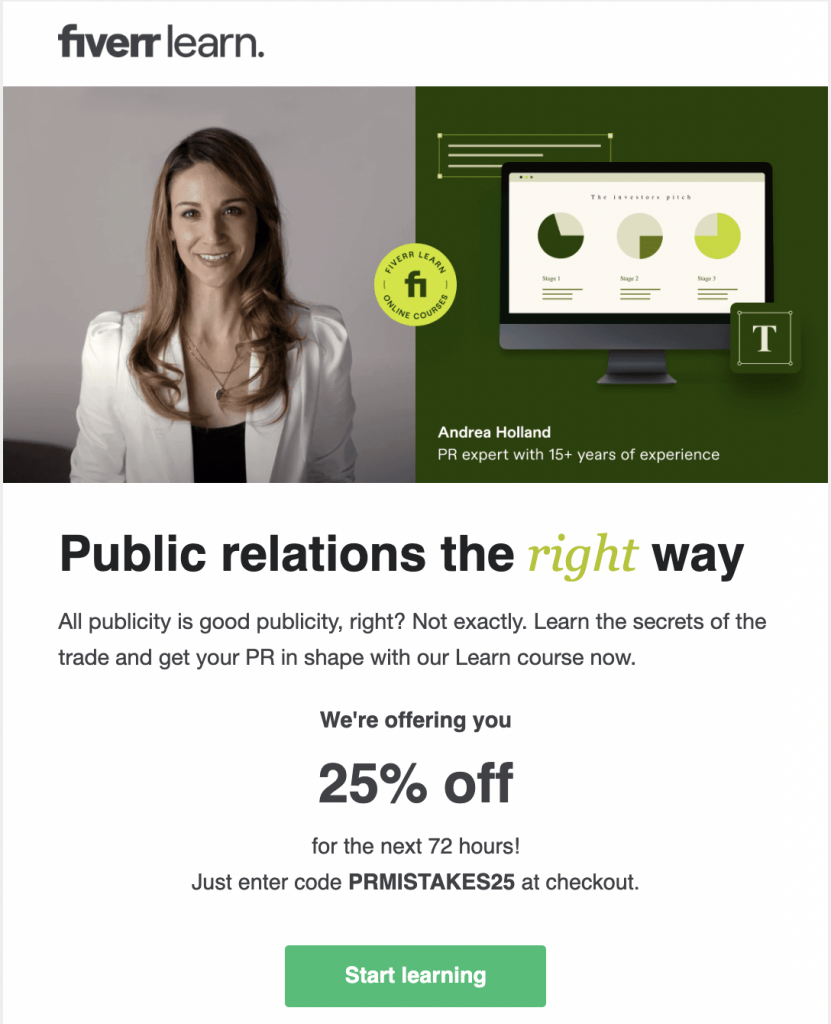
Fiverr is a popular freelance job platform connecting freelance professionals with companies seeking their services. Apart from this feature, Fiverr also runs an educational service to help you develop your professional skills.
The example above showcases one of their sales emails that offer a 25% off coupon if you sign up for their PR course.
Use Case #4: Employer branding
Let’s not forget that companies are not only marketing their products and services to potential customers. They are also competing in the job market as an employer and need to market themselves as an attractive workplace.
One way to sell yourself as a great employer is to improve your brand recognition among your target audience. This audience includes both your existing staff and your potential employees.
Newsletters are a handy tool for employer branding, too. For instance, companies commonly send employee email newsletters to their staff to recognize the achievements of certain employees or teams to motivate everyone and showcase the brand’s commitment to their staff.
Let’s look at such a case.
Example: Joyager Sales
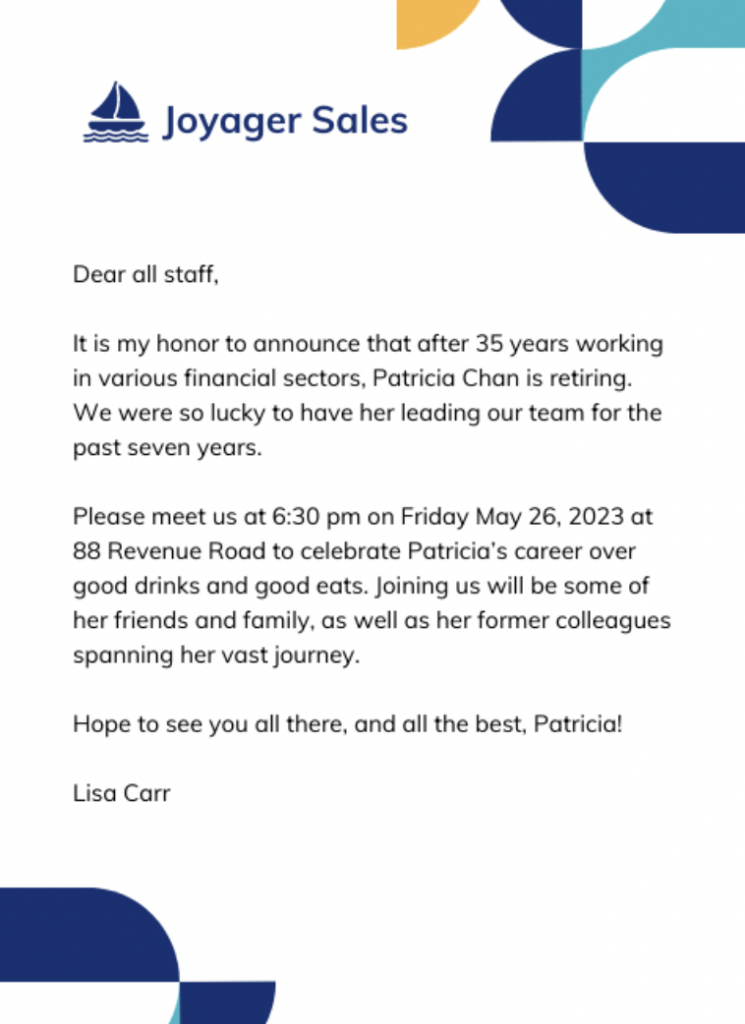
In this newsletter, the leadership team at Joyager Sales is announcing to the entire staff that one of their teammates is retiring, and apart from sharing words of gratitude to this teammate, they invite the entire staff for a small retirement celebration event.
As we can see from the examples above, the uses of email newsletters are quite diverse and can range from attracting job candidates to increasing revenue.
Now, let’s look at the final aspect of email newsletters—the tools and services you can use to run your campaigns.
5 Email Marketing Tools to Create Great Newsletters
In theory, you can run newsletter campaigns using just your email account by adding everyone’s emails into the BCC field and sending an email.
This method, however, is not scalable and has severe limitations, such as a lack of analytics and a 2,000 addresses per message limit.
Instead, I recommend you set up and use a specialized email marketing tool with the right features for managing your email newsletter campaigns.
Here are five such tools that you can consider.
Tool #1: Moosend
Moosend is a specialized email marketing platform you can use for your newsletters.
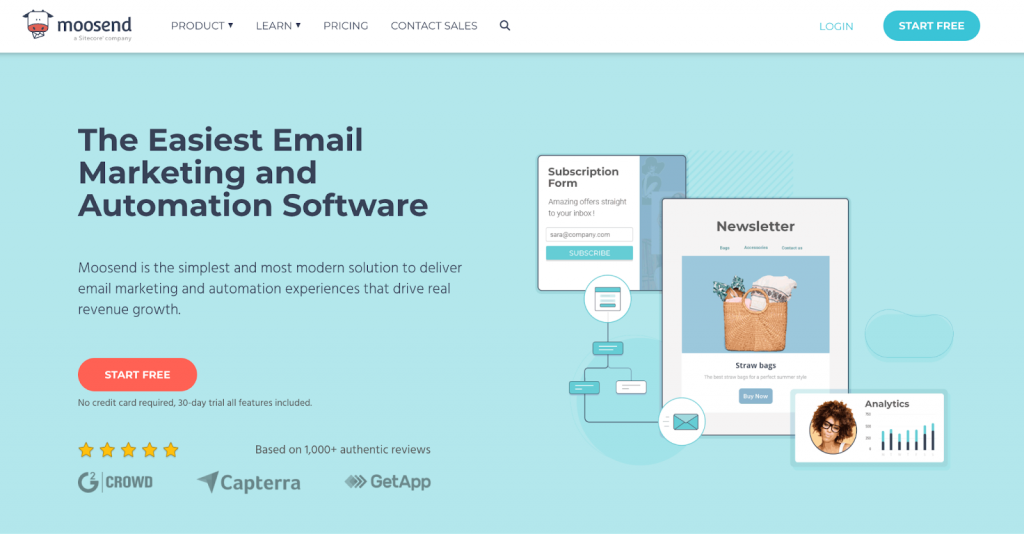
The service covers the majority of use cases for creating and managing email newsletters with features such as:
- Subscription form creation
- Audience segmentation
- Drag and drop newsletter editor
- Simple email analytics (e.g., bounce rate)
- Content personalization
Moosend comes with a free 30-day trial, a Pro version for $9/month for 500 subscribers, and an Enterprise plan for anything custom.
With its easy-to-use interface and lightweight pricing, it is a good fit for managing a relatively small newsletter for a small brand.
Tool #2: Mailchimp
Mailchimp is an all-in-one marketing platform covering multiple channels, including email.
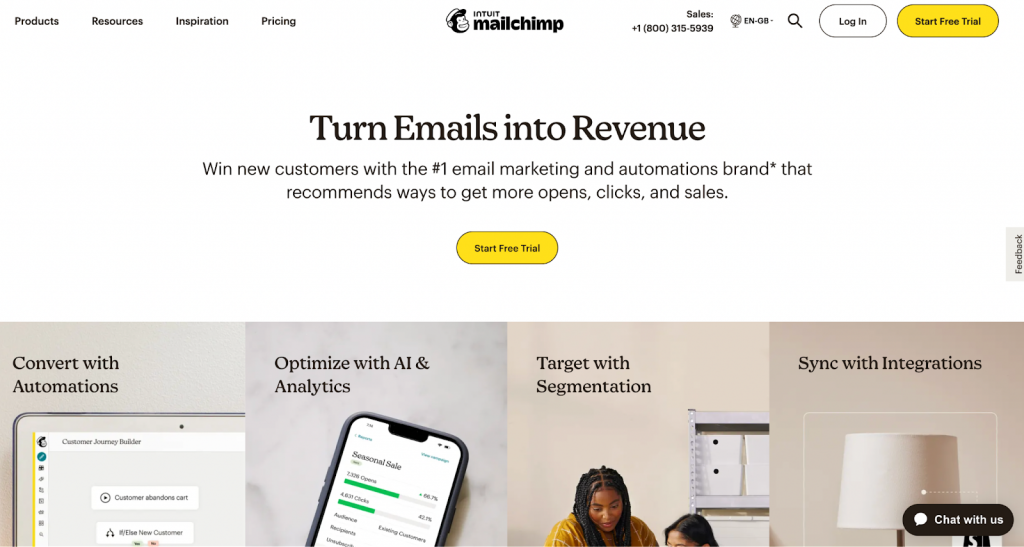
Although you can manage ads and social media with Mailchimp, as its name suggests, its main focus is on email marketing. The platform offers the following features:
- Customer journey builder
- A/B testing
- Subject line templates and assistant
- Content personalization
- Performance reports
Mailchimp comes with four plans:
- A free plan offering 1,000 daily sends.
- Essentials with a 1-month trial and 5,000 daily sends for $13/month.
- Advanced with a 1-month trial and 6,000 daily sends for $20/month.
- Premium with 150,000 daily sends for $350/month.
With its journey management and A/B testing, Mailchimp is a great fit for running more complex email newsletter campaigns for a larger audience.
Tool #3: HubSpot
HubSpot is a multi-disciplinary platform with tools for sales, support, and marketing.

The marketing suite at HubSpot (a.k.a. Marketing Hub) also includes the features necessary for managing email campaigns, including:
- Dynamic newsletter content based on user behavior
- CRM with segmentation
- Shared customer data with other Hubspot tools for behavioral retargeting
- Analytical and monitoring suite showing key metrics (e.g., deliverability, unsubscribe data, email list health, performance on mobile devices, etc.)
The Marketing Hub costs $800/month for 2,000 contacts and $3,600/month for 10,000 contacts.
With its ability to integrate with other HubSpot tools, the Marketing Hub is a good fit for enterprise companies where other teams already use HubSpot for sales and support.
Tool #4: Sendinblue
Sendinblue is a multi-channel digital marketing platform letting you manage social, SMS, and email marketing campaigns.

Sendinblue comes with a standard set of features you can expect from an email service, including:
- Newsletter design builder
- Campaign automation
- Segmentation
- Campaign analytics
- Signup form designer following industry-standard design principles
You can sign up for the following Sendinblue plans:
- Free with 300 emails/day.
- Starter with 20,000 monthly emails costing $25/month.
- Business with additional multi-user support for $65/month.
- Enterprise with custom options and pricing.
With support for SMS and SMM, Sendinblue is a great option if you are running multiple marketing channels along with email.
Tool #5: MailerLite
Unlike the previous two tools, MailerLite is a SaaS service specializing mainly in email marketing.
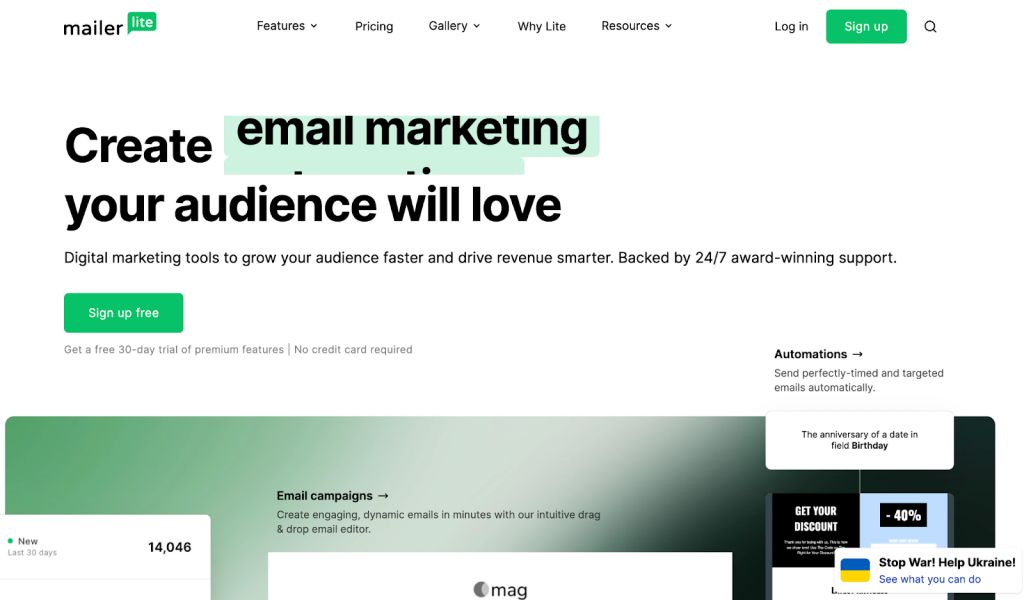
Its capabilities in terms of managing email campaigns include:
- GDPR-compliant eCommerce integration with online store platforms for small businesses, such as WooCommerce and Shopify
- Automated workflows
- Content personalization
- Custom email HTML editor
- Performance monitoring
For those who want to subscribe, Mailerlite comes in four plans:
- Free with 12,000 monthly emails.
- Growing Business with unlimited emails for $9/month.
- Advanced with unlimited users for $19/month.
- Enterprise with custom features and price.
Mailerlite’s suite of features is a good fit for mid-sized companies that run relatively large newsletter campaigns.
Now Over to You
To conclude, email newsletters create a win-win environment for companies and subscribers, as the former get to promote their content and brand, while the latter get to enjoy compelling content that matches their interests.
Emails are one of our favorite topics, and we have many other guides about this channel for you to check out on our blog.

Sona Kalantaryan is a senior digital marketer with a creative past. Big fan of high cinema and well-optimized landing pages. She authors guides by sharing the best practices and does it the right way!
